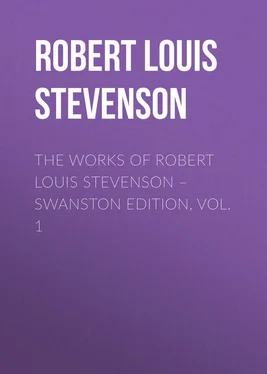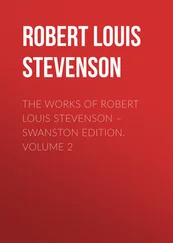Роберт Льюис Стивенсон - The Works of Robert Louis Stevenson – Swanston Edition, Volume 1
Здесь есть возможность читать онлайн «Роберт Льюис Стивенсон - The Works of Robert Louis Stevenson – Swanston Edition, Volume 1» — ознакомительный отрывок электронной книги совершенно бесплатно, а после прочтения отрывка купить полную версию. В некоторых случаях можно слушать аудио, скачать через торрент в формате fb2 и присутствует краткое содержание. Жанр: foreign_prose, foreign_antique, на английском языке. Описание произведения, (предисловие) а так же отзывы посетителей доступны на портале библиотеки ЛибКат.
- Название:The Works of Robert Louis Stevenson – Swanston Edition, Volume 1
- Автор:
- Жанр:
- Год:неизвестен
- ISBN:нет данных
- Рейтинг книги:4 / 5. Голосов: 1
-
Избранное:Добавить в избранное
- Отзывы:
-
Ваша оценка:
- 80
- 1
- 2
- 3
- 4
- 5
The Works of Robert Louis Stevenson – Swanston Edition, Volume 1: краткое содержание, описание и аннотация
Предлагаем к чтению аннотацию, описание, краткое содержание или предисловие (зависит от того, что написал сам автор книги «The Works of Robert Louis Stevenson – Swanston Edition, Volume 1»). Если вы не нашли необходимую информацию о книге — напишите в комментариях, мы постараемся отыскать её.
The Works of Robert Louis Stevenson – Swanston Edition, Volume 1 — читать онлайн ознакомительный отрывок
Ниже представлен текст книги, разбитый по страницам. Система сохранения места последней прочитанной страницы, позволяет с удобством читать онлайн бесплатно книгу «The Works of Robert Louis Stevenson – Swanston Edition, Volume 1», без необходимости каждый раз заново искать на чём Вы остановились. Поставьте закладку, и сможете в любой момент перейти на страницу, на которой закончили чтение.
Интервал:
Закладка:
I seem to remember that I saw the finished manuscript, or perhaps an early copy of the book, and I did not care for it. Mr. Kipling rather surprised me by finding it so very amusing. Mr. Osbourne says that the story "still retains (it seems to me) a sense of failure," and that the public does not relish it. For my own part, on later re-readings, the little farce has made me laugh hysterically at the sorrows of Mr. William Pitman, that mild drawing-master, caught up and whirled away into adventures worthy of the great Fortuné du Boisgobey. The scene in which he is described as the American Broadwood, a person inured to a simple patriarchal life, a being of violent passions; with the immortal John in the character of the Great Vance; and that joy for ever, Uncle Joseph, with his deathless thirst for popular information and instruction—these personages, this "educated insolence," never cease to amuse. Uncle Joseph is no caricature. But the world likes its sensational novels to be written with becoming seriousness; in short, "The Wrong Box" is aimed at a small but devoted circle of admirers.
People constantly ask men who have collaborated how they do the business? As a rule, so some French collaborator says, "some one is the dupe, and he is the man of genius." This was not true, too notably, in the case of Alexandre Dumas, nor was it true in Stevenson's case. As a rule, one man does the work, and the other looks on, but, again, this was not the way in which Stevenson and Mr. Osbourne worked. They first talked over the book together, and ideas were struck out in the encounter of minds. This practice may, very probably, prove unfruitful, or even injurious, to many writers; they are confused rather than assisted. After or during the course of the conversations (when he had an ally), after reflection, when he had not, Stevenson used to write out a series of chapter headings. One, I remember, was "The Master of Ballantrae to the Rescue," an incident in a tale which he began about the obscure adventures of Prince Charles in 1749-1750. "Ballantrae to the Rescue"—the sound was promising, but I do not know who was to be obliged by the Master.
After the list of chapters was completed, Mr. Osbourne used to write the first draft, "to break the ground," and then each wrote and rewrote, an indefinite number of times. The style, the general effect produced, are the style and the effect of Stevenson. "He liked the comradeship." More care was taken than on a novel of which I and another were greatly guilty. My partner represented Mr. Nicholas Wogan as rubbing his hands after a bullet at Fontenoy (as history and I made quite clear) had deprived Mr. Wogan of one of his arms. There is no such error in the "Iliad," despite the unnumbered multitude of collaborators detected by the Higher Criticism.
In June, 1888, Stevenson sailed out on the Pacific in search of health, and followed the shining shadow through the isles and seas till he made his last home at Samoa. It was a three years' cruise among "summer isles of Eden." Perhaps no book of Stevenson's is less popular than his narrative of storm and calm, of beachcombers and brown Polynesian princes. The scenery is too exotic for the general taste. The joy and sorrow of Stevenson was to find a society "in much the same convulsionary and transitional state" as the Highlands and Islands after 1745. He was always haunted, and in popularity retarded, by History. He wanted to know about details of savage custom and of superstitious belief, a taste very far from being universal even in the most highly cultivated circles, where Folklore is a name of fear. He found among the natives such fatal Polynesian fairy ladies as they of Glenfinlas, on whom Scott wrote the ballad. He found a medicine-man who hypnotized him from behind his back, which nobody at home had been able to do before his face. He exchanged stories with the clansmen—Scots for Polynesian; they were much the same in character and incident. He had found, in Polynesia, the way out of our own present. He met a Polynesian Queen—a Mary Stuart or a Helen of Troy grown old. "She had been passed from chief to chief; she had been fought for and taken in war"; a "Queen of Cannibals, tattooed from head to foot." Now she had reached the Elysian plain and a windless age, living in religion, as it were: "she passes all her days with the sisters."
She was not a white woman: none of these people, so courteous and kind, were white, were up-to-date. In London and New York amateurs did not want to be told about them in Stevenson's "Letters from the South Seas." Stevenson "collected songs and legends": fortunately he also worked at "The Master of Ballantrae," in spite of frequent illnesses, and many perils of the sea. "The Master of Ballantrae" was finished at Honolulu; the closing chapters are the work of a weary pen.
He had made tryst with an evil genius that was essential to the conception of the book, and with a hideous tale of fraternal hatred, told by a constitutional coward. Everything is under the shadow of thunder and lit by lightning. A glimpse of Allan Breck, and the babblings of the Chevalier Bourke, are the only relief. But the life is as clearly seen as life in Stevenson's books always is, for example when the guinea is thrown through the stained window pane, or the old serving-man holds the candle to light the duel of brothers who are born foes; or as in the final scenes of desperate wanderings in the company of murderers through Canadian snows. But the book, as Sir Henry Yule said, is "as grim as the road to Lucknow"—as it was intended to be.
A fresh cruise, in the following year, bettered his health, and brought him the anecdote of a mystery of the sea which was the germ of "The Wrecker." He saw Samoa, and bought land there—Vailima—the last and best of his resting-places; and here he was joined, in 1891, by his intrepid mother. He was now a lord of land, a householder in his unpretentious Abbotsford, and "a great chief" among the natives, distracted as they were by a king de facto , and a king over the water, with the sonorous names of Malietoa and Mataafa. Samoan politics, the strifes of Germany, England, and the States, were labyrinthine: their chronicle is written in his "Footnote to History." My conjectures as to the romantic side of his dealings with the rightful king are vague and need not be recorded. "You can be in a new conspiracy every day," said an Irishman with zest, but conspiracies are better things in fiction than in real life; and Stevenson had no personal ambitions, and, withal, as much common sense as Shelley displayed in certain late events of his life. He turned to the half-finished "Wrecker" and completed it.
When the story began to appear in "Scribner's Magazine" it seemed full of vivacity and promise. The opening scenes in the Pacific were like Paradise, as the author said, to dwellers in Brixton, or other purlieus of London. The financial school at which Loudon Dodd was educated in Stock Exchange flutters was rather less convincing than any dream of Paradise, but none the less amusing. At home in Edinburgh, with the old Scottish master of jerry-building and of "plinths," the atmosphere was truly Scots, tea-coseys and all, while the reminiscences of Paris and Fontainebleau, and the grandeurs et misères of "the young Americo-Parisienne sculptor" were perfectly fresh to the world, though some of the anecdotes were known to Stevenson's intimates. Mr. James Pinkerton is a laudable creation, with his loyalty, his innocence, his total ignorance and complete lack of taste, and his scampers too near the wind of commercial probity. The spirit of hustle incarnate in a man otherwise so innocent, the ideals caught from heaven knows what American works for the young, and the inspired patriotism, the blundering enthusiastic affection, make the early Pinkerton a study as original as it is entertaining.
Читать дальшеИнтервал:
Закладка:
Похожие книги на «The Works of Robert Louis Stevenson – Swanston Edition, Volume 1»
Представляем Вашему вниманию похожие книги на «The Works of Robert Louis Stevenson – Swanston Edition, Volume 1» списком для выбора. Мы отобрали схожую по названию и смыслу литературу в надежде предоставить читателям больше вариантов отыскать новые, интересные, ещё непрочитанные произведения.
Обсуждение, отзывы о книге «The Works of Robert Louis Stevenson – Swanston Edition, Volume 1» и просто собственные мнения читателей. Оставьте ваши комментарии, напишите, что Вы думаете о произведении, его смысле или главных героях. Укажите что конкретно понравилось, а что нет, и почему Вы так считаете.












